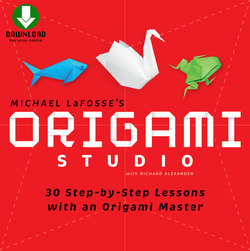Читать книгу Origami Studio Ebook - Michael G. LaFosse - Страница 10
На сайте Литреса книга снята с продажи.
ОглавлениеOrigami Symbols and Tips
Origami instructions are most commonly expressed in line drawings called diagrams.
Diagramming language has been standardized so regardless of the language the book uses, the folding diagrams and symbols are the same. If you are familiar with this system of arrows and dashed lines, you will probably be able to fold a model from an origami book written in Japanese, French, English, German, Spanish, or any other language, since you do not need to read the words to follow origami diagrams. Learning to follow origami diagrams is much like learning to read sheet music, a new language, or a mathematical expression. While the symbols are simple, it still takes time and practice to develop a working knowledge, even for “simple” or “beginner” projects. You would not expect to be able to play even a simple tune on the piano from unfamiliar sheet music if you didn’t know one printed note from another. It is the same with origami diagrams. Here is a visual key to the standard diagram language of origami. Don’t bother to memorize all of these symbols in one lesson. It will not take too many lessons for you to fold simpler models, and with time, you will be able to read fairly complex origami diagrams ease.
Origami symbols are easy to follow if you know the language. Mountain folds are indicated with dots between the dashes. Valley fold lines have only dashes. Several mountain and valley folds together in the same diagram often illustrate more complex maneuvers. The best clue is to look to the next drawing to see the resulting shape.
“Origami paper,” such as the kind supplied in this kit, is conveniently already cut square and comes in many colors. It is thin and it folds well for most simple-to intermediate-level projects. But what will you do when your supply runs out?
Almost any kind of paper can be used for origami. Some choices will be better than others for different reasons. Develop the habit of practicing a new origami model by folding it in several available papers: printer and letter papers, gift wrap, newspapers and magazines, old calendars, or even brown paper bags. This is a great way to learn about the different qualities of papers, and with this experience, you will be better able to imagine which papers will be the most suitable for new projects.
You will need to cut the paper to the proper size and shape. The most common shape is a square, which is easy to make. We use two methods for measuring and cutting squares, as illustrated to the right.
To turn a long rectangle into a square, fold at a 45-degree angle, short edge to long edge. Trim and unfold.
If a diagonal crease is not desired, simply take another sheet of the same dimensions, turn it 90 degrees, and lay a corner atop the first sheet. Trim the excess.
